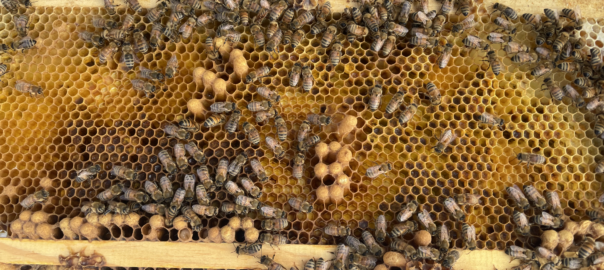During the pollination season, commercial honey bee colonies are exposed to various xenobiotic chemicals, an additional stressor that can affect colony health and survival. These mixtures comprise substances from both intentional applications (crop pesticides and in-hive medicines) and unintentional exposure to environmental pollutants. Current pesticide management strategies aim to protect honey bee health. Yet, they often are limited to single chemical exposures to adult worker bees. Environmentally relevant exposures to chemical mixtures and the effects on vulnerable hive members, including the Queen bee and developing larvae, are still understudied.
Multidrug resistance (MDR) or multixenobiotic resistance (MXR) transporters are key determinants of chemical uptake in all organisms. In flies and honey bees, the multidrug resistance 49 (MDR49) protein is one of the best-characterized chemical efflux pumps. It has been shown that pharmacological inhibitors of these proteins can lead to an increase in crop pesticide accumulation and mortality in bees. Our lab seeks to understand how legacy and emerging pesticides, in-hive medicines, and mixtures thereof interact with these crucial cellular defense systems to help predict and mitigate toxic chemical bioaccumulation in honey bees. Another interest of the lab is to identify and trace chemicals and their possible metabolites within and across bee hive members.
Our ongoing research projects are:
- Project 1: Hive member interactions and chemical flow: In this project, we aim to characterize environmental chemical flow from “nectar to honey” by tracking parent compounds and possible metabolites in the different biological matrices from the plant en route to honey. The overall goal is to identify toxicological nexuses within the bee hive and to develop mitigation strategies to dilute and/or replace those hot spots to improve colony health and the safety and quality of bee products.
- Project 2: Interactions of pesticides and chemical mixtures with bee drug transporters: In this project, we aim to clone, express, and purify the major drug and chemical efflux transporters in honey bees. The main goal of this project is to develop high throughput in vitro transporter/chemical interaction assays that can be used to rapidly screen for their bioaccumulation potential in non-target pollinator organisms.
Future Directions:
- Susceptibility of honey bee gut microbiota to pesticides: In this project, we seek to understand how chemicals ingested through water, nectar, pollen, and propolis can affect the gut microbial community structure and health in honey bees.
- Real-time exposure to air pollutants: A developing project in the lab is interested in analyzing the exposure risks of pollinators to pesticide emission plumes during summer and wildfires in CA. Using a drone system equipped with a chemical scavenging resin, we envision localizing exposures of forager bees to air pollutants in agricultural fields.
